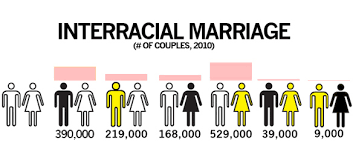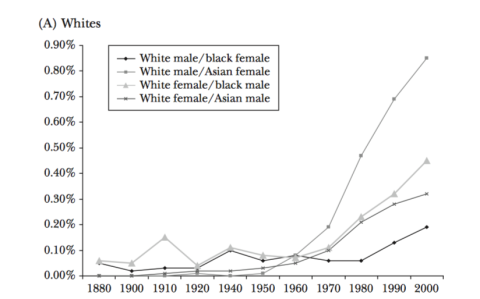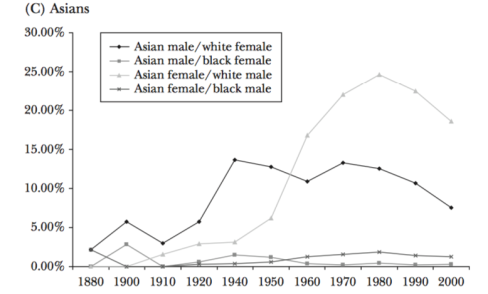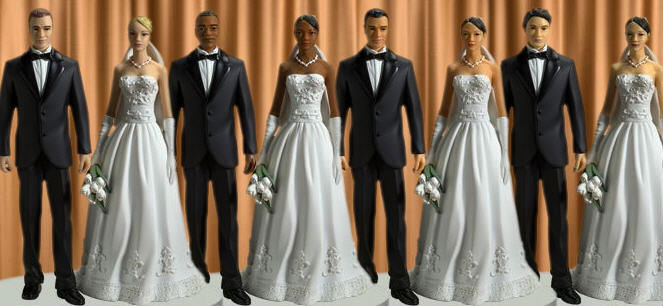By: Tracy Dang
The growth of interracial marriage has increased throughout the years and has become an impact in today’s society. Interracial marriage is a form of exogamy that involves marriage between spouses. With the development of interracial marriages, more cultures are coming together and creating more diversity around the world. In certain states, interracial marriages were illegal. In 1967, “Supreme Court ruling of Loving v. Commonwealth of Virginia, which overturned state laws prohibiting interracial marriage and sex. As recently as 1967, interracial marriage was illegal in sixteen states, but today about 13 percent of American marriage involve partners of different races” (Lee and Bean 2010). After interracial marriage was legalized, the rates of interracial marriages were increasing from 150,000 to 1.6 million in 1990. In an article it states, “if we go back to even further to 1880, the rates of interracial marriage among Asian and Latinos in this country were close to zero, but now, more than a quarter of all Asians and Latinos marry someone of a different racial background, mostly whites” (Lee and Bean 2010). This demonstrates that the rates of interracial marriages are higher and with native-born Asians and Latinos, the rates will most likely increase in future generations.
With older generations, interracial marriages were often looked down upon in many cultures and were rare. When immigrants would come to America, many of the Whites would look at them as “foreign” and have stereotypical view causing the rates of interracial marriages between them to be low. With the increase of interracial marriages, it is shown that different races are more likely to intermarry with Whites. In an article it states, “not only is intermarriage more common among Asians and Latinos than among blacks, but the rate at which Asians intermarry with whites is also much higher. Among intermarried Asians, 86.8 percent marry whites, 7.6 percent intermarry Hispanics, and 4.8 percent marry blacks” (Lee and Bean 2010). As time went by, interracial marriages among Asian Americans had many factors, trends and patterns evolved, and the overall significance and meaning of interracial marriage was shaped.

There have been many factors that have played roles into interracial marriages among Asian Americans. Some of those factors include race, education, and demographics. Different races definitely have an affect with interracial marriages. It is most common that different races such as Blacks, Hispanics, and Asian Americans would intermarry with Whites. In a study, it states, “individuals may classify themselves as belonging to one or more racial groups in the American Community Survey, but were forced in every census before 2000 to self-identify as a single race. Sensitivity analysis suggests that Asian–White mixed race and American Indian–White mixed race individuals are more likely to classify themselves as White than as either Asian or American Indian in earlier censuses” (Qian and Lichter 2011). This demonstrates that even as mixed race, Whites are almost always considered the top of hierarchy when it comes to race.
Education is another factor that plays a role in interracial marriages. Studies have shown that the higher the education level, the more likely there is for intermarriage. An article states, “College-educated men and women are more likely to marry interracially than those with less education. The fact that Asian Americans attend college at unusually high rates helps explain their high level of intermarriage with whites” (Qian 2005). This study not only shows how education level can affect interracial marriages but also demonstrates the high level of Asian Americans intermarrying with the Whites. Demographic also contributes to the factors of interracial marriages. With immigration increasing, the population growth of America’s racial/ethnic minorities has impacted the growth of economic and cultural diversity within minority groups. Many immigrants are disproportionately unskilled, have low economic status and have limited English proficiency. They tend to live in economically segregated neighborhoods with limited opportunities for interaction with mainstream. In an article it states, “for new immigrants, the lack of opportunities for socioeconomic mobility, coupled with limited social contacts with mainstream society, magnifies their social distance form whites compared with their native-born counterparts. Marriages between minority immigrants and whites are less likely to occur as results; immigrant minorities are less likely to cross the racial divide” (Qian and Lichter 2007). Another reason why interracial marriages between immigrants and Whites are so low is derived from the stereotypical and negative views that they perceive their native ways. “The interracial marriage rates are much higher for American-born racial minorities: 9 percent for African Americans, about 39 percent for Hispanics, 56 percent for American Indians, and 59 percent for Asian Americans” (Qian 2005). These statistics show that not only are American-born minorities more likely to intermarry but also how Asian Americans are the highest percentage to intermarry.
In interracial marriages, there have been many trends and patterns that have evolved over time. One of the trends that changed over the years in interracial marriages involves gender. In 1880-1960, Asian men were more likely than Asian women to intermarry with Whites. In an article, “rather than increase monotonically over time, Asian men intermarrying with whites rises until 1940 and then decreases. Asian females exhibit the opposite pattern, showing dramatic increases in inter- marriage with whites until 1980 and then a slow decrease. Until 1960, Asian men were more likely than Asian women to intermarry with whites. By the 2000 census, however, this trend had reversed. Asian women are almost twice as likely to marry a white person as Asian men” (Fryer 2007). Another study demonstrates, “on a percentage point basis, the sex difference was even larger, but in the opposite direction, among Asian Americans – only 26 percent of men but 29 percent of women married interracially in 2000” (Qian and Lichter 2007). One of the reasons that could be cause to the gender shift is due to the racial stereotypes of Asian American men. There are mainly portrayed in disapproving ways in society such as being nerdy, inexperienced, and less masculine. Another trend and patterns that has changed over time in interracial marriages involve the education level between the spouses. The education levels in interracial marriages shift from being less – educated to more – educated. In a study by Roland Fryer, “from 1940 – 1960, about 8 – 12 percent of marriages of Asian men with less than a high school education were outside the race. For Asian men with higher levels of education, the rate of intermarriage was typically 1 – 2 percent in these years. But the rate of intermarriage for low –educated Asian men has since plummeted to 1 percent in 1990 and almost zero by 2000, while the rate of intermarriage for Asian men with college education or more had risen above 4 percent by 1980” (Fryer 2007). This demonstrates the pattern change in the education level for Asian men and how overtime the more educated they are, the more likely they were to intermarry.


Similar patterns were shown for Asian women in education levels. “From 1950 to 1980, Asian women with a high school education or less were more likely to intermarry than those with more education, at rates of 8–10 percent. But by 2000, intermarriage rates for Asian women with less than a high school education had dropped again, to 2 percent, while intermarriage rates for Asian women with a college education or more had risen to 8 percent” (Fryer 2007). These two studies correlate with the gender pattern in interracial marriages, such as how many Asian women in the 1880s – 1960s would rarely intermarry with the Whites but as time went by the rates started to increase. One thing I found interesting about comparing these two trends were how Asian men were decreasing over time in intermarriage due to the racial stereotypes but with education level, the rates would cause an increase in intermarriage. In contrast, the Asian women would have an increasing rate in both trends and patterns that developed over time.
The growth of interracial marriages over the past few decades have shaped and revealed the significance and overall meaning of interracial marriages. One of the significance of interracial marriages revealed the generation gap from dating and parental reservations. Today, many young women and men are more open to interracial relationships than their parents are. Also, with today’s generation, many young teens and adults tend to push boundaries when it comes to dating and breaking the stereotypes on marrying within their race. In a study it shows, “40 percent of third-generation Asians intermarry today and that the children of this union have the option to identify as ‘White’” (Lee and Bean 2010). This statistic clearly shows that the rates of intermarriage for newer generations are increasing.
Another significance and meaning of interracial marriages the emerged over time refers to White hierarchy. Jennifer Lee and Frank Bean states, “Whites are believed to be on top of the social hierarchy, intermarriage will come at a social cost, but interracial marriage with Whites is a benefit to other group” (Lee and Bean 2010). This portrays that intermarrying with Whites will be more of an advantage than intermarrying with the other races. This also explains why rates for intermarriage with Whites are so high as compared to marriages that involve Asian Americans and Blacks. In the same article it states, “the Mississippi Chinese achieved near white status by attaining economic party with whites, emulating their culture and social practices, and distancing themselves from African Americans and the Chinese who married blacks. The change in racial classification among ethnic groups from nonwhite to white or almost white illustrates that race is social rather than biological category that has expanded over time to incorporate new immigrant groups” (Lee and Bean 2010). The significance of this statement demonstrates how interracial marriages with Whites are more of a form to fit into the American society than it is of sharing both cultures in a marriage. Also, another significance that represents interracial marriages among Asian Americans and Whites involve the stereotypes of Asian American women being submissive and exotic. An article states, “some speculate Asian American women tend to marry White men because they perceive Asian American men to be rigidly traditional on sex roles an White men as more nurturing and expressive. But what attracts white men to Asian-American women? Some scholars suggest that it is the widespread image of Asian women as sub- missive and hyper-feminine (the “Madame Butterfly” icon)” (Qian 2005). This is another significant meaning on how interracial marriages can really be portrayed among Asian American women and Whites.
From the time when interracial marriages were unconstitutional to now being an impact in American society, many changes have developed and meanings have been portrayed. Factors such as education, different races, and demographics have an affect in interracial marriages. Trends and patterns have changed over time and new generations are becoming more involved with interracial relationships. As for the meaning and significance of interracial marriages, many studies have shown that racial hierarchy such as the Whites seem to be a more over powering role in society.

Work Cited
Fryer, Roland G. “Guess Who’s Been Coming to Dinner? Trends in Interracial Marriage
over the 20th Century.” Journal of Economic Perspectives 21.2 (2007): 71-90. Web.
Lee, Jennifer and Frank D. Bean. The Diversity Paradox: Immigration and the Color
in Twenty-first Century America. New York: Russell Sage Foundation, 2010. Print.
Qian, Zhenchao, and Daniel T. Lichter. “Changing Patterns of Interracial Marriage in a
Multiracial Society.” Journal of Marriage and Family 73.5 (2011): 1065-084. Web.
Qian, Zhenchao., and Daniel. T. Lichter. “Social Boundaries and Marital Assimilation:
Interpreting Trends in Racial and Ethnic Intermarriage.” American Sociological Review 72.1 (2007): 68-94. Web.
Qian, Zhenchao. “Breaking the Last Taboo: Interracial Marriage in America.” Contexts 4.4
(2005): 33-37. Web.

“An article states, “some speculate Asian American women tend to marry White men because they perceive Asian American men to be rigidly traditional on sex roles an White men as more nurturing and expressive. But what attracts white men to Asian-American women? Some scholars suggest that it is the widespread image of Asian women as sub- missive and hyper-feminine (the “Madame Butterfly” icon)” (Qian 2005). This is another significant meaning on how interracial marriages can really be portrayed among Asian American women and Whites.”
This section from your article was pretty intriguing. I do not doubt that the marriage rates among Asian women and white men are really high. But, as mentioned above, these kinds of intentions are pretty unsettling. The American G.I.’s exploitation of the Asian woman has greatly influenced the way Asian women are perceived. This ultimately serves as one of the main reasons as to why Asian women are deemed as submissive and hypersexual. This fact might just leave a person to be skeptical about unions between Asian women and white men. Ultimately, this leaves room for much criticism over such unions, even if the intentions from both parties are different from the preconceived ones mentioned above.
Interesting read.
-Joanne Villanueva
LikeLike